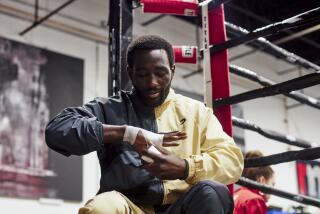A Breathtaking Million-Dollar Fight : Boxing: It had never happened until 70 years ago today, when Jack Dempsey knocked out Georges Carpentier.
Seventy years ago today, a prizefight between a western mining camp saloon fighter and a French war hero provided boxingâs first million-dollar fight.
Million-dollar matches today go pretty much unnoticed. Some give Mike Tyson and Evander Holyfield, if they fight, a chance to generate $100 million. When Tyson and Razor Ruddock fought at the Mirage in Las Vegas Friday night, the live gate was $6.2 million.
But when Jack Dempsey fought Georges Carpentier on July 2, 1921, the gross receipts--$1,789,238--were more astonishing than the fight, won routinely by Dempsey on a fourth-round knockout.
In 1921, a million-dollar fight took your breath away. Literally. The New York Timesâ headline on the morning of the fight:
â Zero Hour Overhangs
A Breathless Cosmosâ â
The previous biggest fight gate was $452,522.10 for the 1919 Dempsey-Jess Willard fight. Before that, the 1910 Jack Johnson-Jim Jeffries fight, $270,775.
The promoter of all three was Tex Rickard, a onetime Texas cowboy and Alaska gold miner who discovered as a young man that men will pay almost anything to see a major fight.
In early 1921, he signed Dempsey and Carpentier, then borrowed $250,000 to build what might have been the most remarkable structure in the history of American sports--a temporary, 91,613-seat stadium at Jersey City, N.J.
The stadium was built in nine weeks on a piece of land known as Boyleâs Thirty Acres, at the corner of Montgomery Street and Cornelison Avenue. Octagonal, it covered seven acres. The final row of bleachers rose 34 feet from the ground and was 312 feet from the center of the ring.
Rickard priced the seats from $50 ringside to $5.50 and said years later that he should have doubled the prices, because the fight sold out. Dempsey-Carpentier would stand as boxingâs richest fight until Rickardâs 1926 and â27 Dempsey-Tunney fights made $1,895,733 and $2,658,660.
Between 1921 and the first Muhammad Ali-Joe Frazier fight in 1971, there were only eight million-dollar fights. But with the advent of, first, closed-circuit television then home pay-per-view, the earning power of major fights increased enormously.
Prize fights technically were illegal in New Jersey in 1921, but Rickard had skirted such laws before. To build his giant stadium, he hired contractors C.S. and J.W. Edwards, brothers of New Jersey Gov. Edward I. Edwards.
July 2, 1921: Mississippi Congressman Paul B. Johnson had just introduced a bill that would make it illegal for women to smoke cigarettes in Washington, D.C. Babe Ruth, on his way to a 59-home run season, had 28 and was batting .366.
In Los Angeles, the hit movie was âPeckâs Bad Boy,â starring Jackie Coogan. Childrenâs admission at the Alhambra, between 7th and 8th Streets, was 11 cents. At the Pantages, at 7th and Hill, for 65 cents, you could follow Dempsey-Carpentier reports, telegraphed from ringside and read to the audience by a man with a megaphone.
New homes in Venice were listed for $2,140, or $321 down and monthly payments of $25. Clark & Coberly Ford on West Pico was selling new Fords with automatic starters for $485.
And in Jersey City, Jack Dempsey was about to make the easiest $300,000 of his career.
Georges Carpentier was the world light-heavyweight champion when he fought Dempsey. A World War I hero, he was idolized in France. An aviator, Carpentier was decorated for flying spotter planes through heavy enemy fire, reporting on German positions.
When he was awarded the Croix de Guerre and the Medaille Militaire, it was said that Carpentier had many times landed in planes that were âsplinteredâ with machine gun fire and shell fragments.
Dempsey was tried by the federal government on a draft-dodging rap in 1920. When introduced at fights, Dempsey was jeered with shouts of âslacker!â as much as he was cheered.
He grew up a western hobo, riding the rails between mining towns in Colorado, Utah and Nevada. He fought in saloon bare-knuckle bouts, after which the hat was passed for the participants.
Rickard discovered Dempsey, matched him expertly and got him a title shot with champion Jess Willard in 1919. As a big underdog, Dempsey knocked out Willard in three rounds.
At his 1920 trial for draft evasion, Dempsey was charged with having falsely claimed during the war that he was the sole support of his parents, wife and brothers. He was given deferred draft status.
At the trial, he testified that he was the sole provider for his family since he was 14 and presented documentation that he earned $4,000 in 1917 and given nearly all of it to his family. A jury acquitted him.
The day after the Carpentier fight, the Tulare (Calif.) American Legion Post announced it would urge the national American Legion commander to pay $250,000 to any former serviceman who would beat Dempsey.
The buildup for Dempsey-Carpentier was more artful than the fight. Dempsey trained at a small outdoor arena in Atlantic City. Films of his workouts show several hundred spectators--admission was $1--watching him train with smaller, quicker sparring partners.
How big a fight was it? At training camp, when Dempseyâs German shepherd, Ginsberg, was hit by a car and injured, reporters covered not only the accident, but also Dempseyâs visits to the dog hospital.
Carpentier trained at Manhasset on Long Island. Training-camp movies show him performing an unusual drill--punting American footballs straight up in the air and then catching them. His sparring sessions were all held behind lock and key, possibly on Rickardâs orders. It was believed that he didnât want anyone to see how small Carpentier really was.
Dempsey was a big heavyweight for his day, 6 feet 2, and weighed between 185 and 192 pounds for his championship fights. For this fight, Carpentier weighed in at 172, Dempsey 188. As films show, it was simply a matchup of a bigger, quicker man against a smaller, slower man.
Carpentierâs bravery, described in numerous prefight stories, was never a factor.
The handsome Carpentier, whose nickname was âthe Orchid Man,â entered the ring in a wreath of orchids, waving and smiling at the massive crowd. Dempsey entered unshaven, hair uncombed and wearing a short, nondescript robe.
Surprisingly, Carpentier began the fight aggressively, hooking to Dempseyâs head and body at close quarters. Dempsey hurt Carpentier with a right hand to the ribs. Then came a close-quarters exchange, and when they broke, Carpentier had a cut on the side of his nose.
Carpentier came out for the second round carrying his left hand very low, but when he landed a left hook on Dempseyâs jaw and snapped the championâs head back with three more punches, the crowd began leaping to its feet, row by row. At the bell, Dempsey seemed to be holding on to Carpentier.
Early in the third round, Dempsey landed several punishing body blows. After that, Carpentier was flat-footed and began backing up. After switching to a retreating, hit-and-run game, Carpentier suddenly seemed much smaller, much more vulnerable.
In the fourth round, Dempsey hurt Carpentier on the ropes with a short, chopping right to the jaw and again the crowd rose. But Carpentier, in what would be his last rally, connected with two right uppercuts to Dempseyâs chin.
Dempsey began closing the show with a stiff left jab, followed by a straight right. Carpentier crumpled to the mat and struggled to rise. He collapsed again, then leaped to his feet at the nine count.
But he was soon down again, this time for good. He was unconscious as he was counted out, lying on his side, his face on the mat. The finishing combination for Dempsey was a right to the ribs and a left to the chin. Dempsey helped Carpentierâs seconds carry their fighter to his corner.
The biggest winner was Rickard. He cleared $600,000, even after paying off the fighters and retiring the loan for the stadium, which was used only for that one event.
Rickard, who promoted three more million-dollar Dempsey fights, died of appendicitis in1929.
Dempsey, shorn of his title by Gene Tunney, retired in 1928. He was 87 when he died in 1983.
The year after Dempsey knocked him out, Carpentier lost his light-heavyweight title when he was knocked out by Battling Siki. Carpentier retired in 1927 and died at 81 in 1975.
More to Read
Go beyond the scoreboard
Get the latest on L.A.'s teams in the daily Sports Report newsletter.
You may occasionally receive promotional content from the Los Angeles Times.










